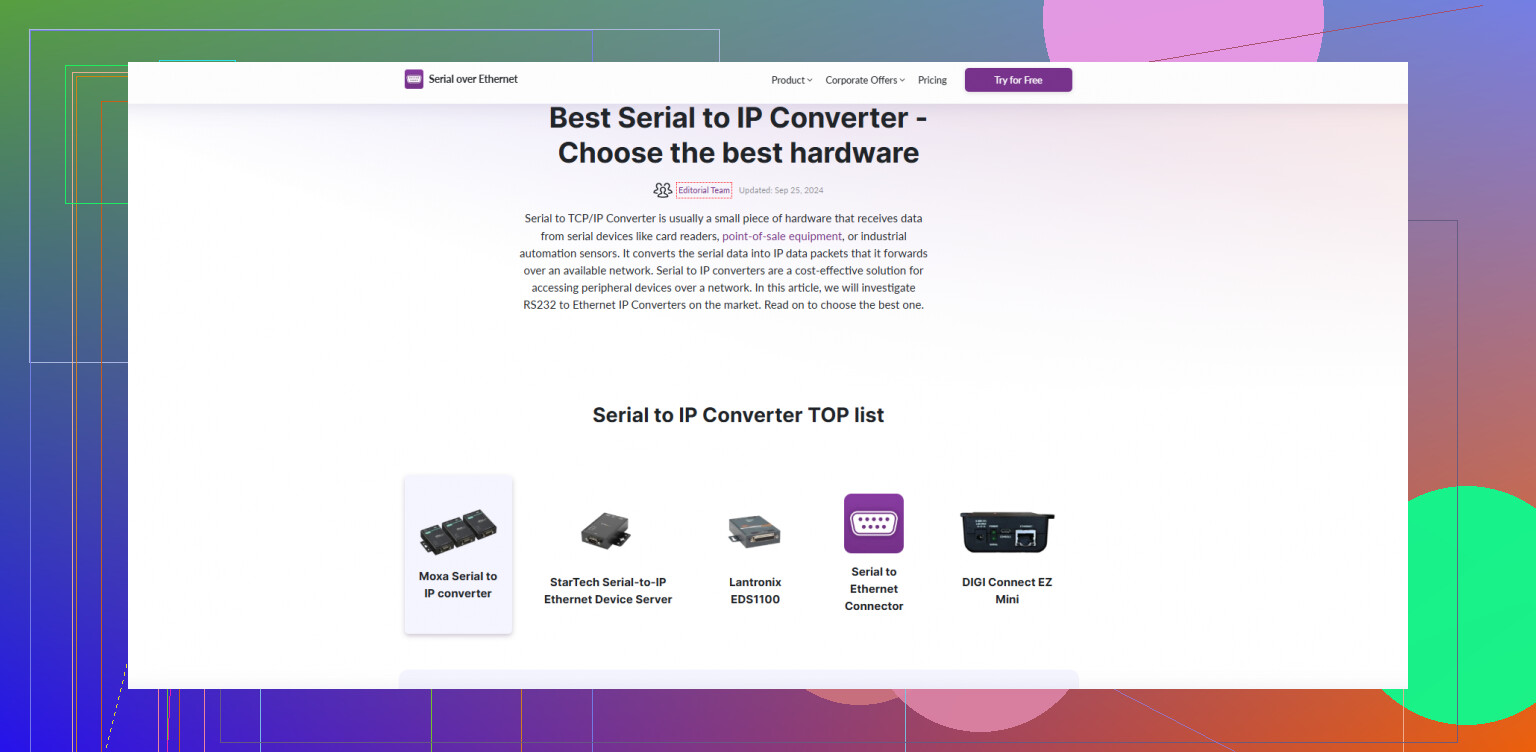I’m searching for the best serial to IP converter for a project, but I’m overwhelmed by all the different models out there. I need something dependable that won’t have connectivity issues. Has anyone had good experiences with a certain brand or product, and why does it stand out? My current setup keeps dropping connections and it’s causing problems. Any suggestions or tips would be greatly appreciated.
I’ve burned through more serial to IP adapters than I care to admit—half of em mysterious little black boxes from Amazon that drop connections more often than my neighborhood WiFi. If you need something bulletproof for stable RS232/RS485/RS422 to TCP/IP communication, hardware matters: look for names like Digi, Moxa, or, if software-based virtualization is cool for your project, check out Serial to Ethernet Connector. Seriously, that thing takes your local COM ports and makes them accessible over any network, and I’ve yet to have it flake out on a live industrial system (which is more than I can say for a couple hardware dongles I’ve tried). Plus, setting up virtual serial port redirection is way easier than fiddling with a wonky box’s DIP switches.
If you want a rundown and some hands-on feedback, this deep dive guide to serial devices over network helped me compare a few options, both hardware and software. At the end of the day, if you can swing the cost, just avoid the no-name adapters and either go with a recognized brand or use Serial to Ethernet Connector for rock-solid connectivity (bonus: you get the flexibility to manage ports from different machines without crawling behind racks). Hope that narrows it down a little—there are SO many flaky options, but you only need one that works!
Honestly, I feel like every time someone asks for “the most reliable Serial to IP converter,” you get bombarded with the same three brand names. You know, the ones @nachtdromer mentioned—Digi, Moxa, etc., which are totally solid for industrial stuff, but let’s be real, sometimes you just need to skip the industrial price tag and the endless firmware updates that come with them. Funny thing, I actually BURNED through a Moxa unit at a wastewater plant once (don’t ask, water and serial ports don’t mix), so apparently even the “bulletproof” units have their moments.
Here’s the thing nobody usually says: sometimes a physical box is legit overkill, especially if you’re only dealing with a handful of serials, or (gasp) you’ve got fluctuating IP address situations or have to access those serial devices from multiple places. In those cases, a software-based serial over Ethernet solution works better and causes less grief in terms of setup and troubleshooting, especially if you’re tired of crawling under desks figuring out what’s loose this time. If you haven’t looked at Serial to Ethernet Connector yet, you totally should. No joke—it turns your existing RS232/RS485 port into an Internet-accessible, totally manageable “COM port from anywhere.” If your “reliability” means never physically touching the setup after installation, this is your bestie.
And here’s a little SEO bonus, because you’d probably find this handy: for projects where you’re juggling multiple devices, I’d suggest checking out remote access solutions for serial ports. Seriously, it lets you keep tabs on who’s doing what, on what port, from wherever. If I’d had that back in the day, maybe my Moxa wouldn’t have ended up with rust instead of data.
But hey, not to dunk on boxes—if you’ve got power constraints or work in weird environments, hardware still sometimes reigns. Just…if you care about less downtime and minimal headaches, software serial port redirection is worth a look, despite what some die-hard hardware folks say.
Let’s just lay it out: in serial-to-IP land, everyone’s got war stories—fried boxes, dropped packets, the occasional deep regret over “bargain” models. @cacadordeestrelas and @nachtdromer hit the big points with Digi and Moxa (solid gear, but not always budget-friendly—and I, too, have seen even those freeze up under real-world muck). That said, hardware’s great until you’re managing a tangle of devices or need to flick a switch from the other side of the planet.
Here’s where Serial to Ethernet Connector enters the chat. I’ll toss a few quick pros and cons your way:
Pros:
- Ridiculously easy setup compared to tinkering with jumpers on a black mystery box.
- Lets you map serial ports across networks, so you’re not tied to a single desk or server room forever.
- Fantastic for remote access—seriously, onboarding new devices or shifting workflows happens in clicks.
- Plays nice with virtualization and supports RS232, RS485, RS422.
Cons:
- Needs a Windows environment to run, so if you’re pushing Linux-based SCADA systems, it’s not a turnkey fit.
- If your network flakes out, you might lose the virtual port connection (though, frankly, that’s true of all networked options).
- Licensing costs can add up if you scale beyond a hobby project.
Competitors? Well, those big-name boxes from folks like Digi/Moxa are tried-and-true for brutal shop floors and power failures, but you pay up and get industrial quirks like overcomplicated firmware. @cacadordeestrelas highlighted burning out a “bulletproof” Moxa—relatable! And @nachtdromer already called out the sketchy Amazon boxes that look cool until they blink out mid-shift.
For me, if rock-solid means “I don’t have to fix it every time the janitor knocks the plug loose,” the Serial to Ethernet Connector is top-tier—for transparent, multi-client access and a deep breath moment when it just works. I wouldn’t trash hardware if you’re running mission-critical plant gear, but for anything else—or if you get the sweats thinking about firmware updates at 2AM—the software route is refreshing.
If you want lowest downtime with high agility (and don’t mind running Windows), Serial to Ethernet Connector kind of nails it. Just keep the licensing in mind and have a fallback when networks go haywire (nothing beats a good old-fashioned serial cable in a pinch).
